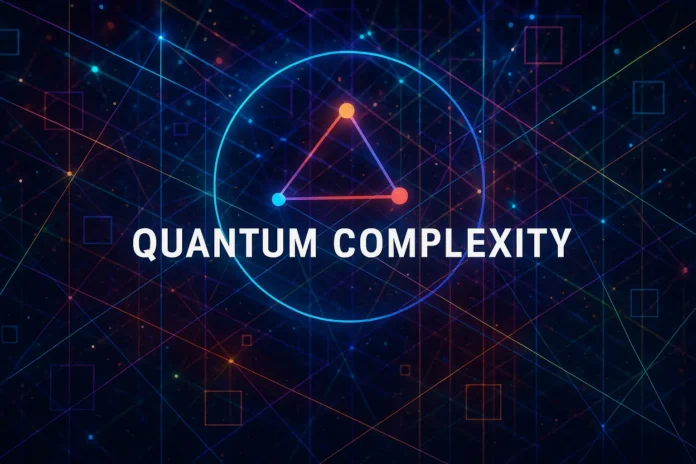Table of Contents
- Introduction
- What Is Meta-Complexity?
- Classical Meta-Complexity: A Recap
- Meta-Complexity in the Quantum Setting
- Quantum Kolmogorov Complexity
- Measuring Descriptions of Quantum States
- Quantum Circuit Minimization
- Meta-Computational Complexity Classes
- Quantum Circuit Lower Bounds and Meta-Complexity
- Quantum Descriptive Complexity and QKC
- Advice Complexity and Meta-Reasoning
- QMA vs QCMA and Meta-Verification
- Universal Quantum Circuits and Meta-Programming
- Meta-Complexity of Quantum Machines
- Quantum Self-Testing and Introspection
- Quantum Meta-Algorithms
- Cryptographic Connections
- Open Questions in Quantum Meta-Complexity
- Philosophical and Foundational Implications
- Conclusion
1. Introduction
Quantum meta-complexity studies the complexity of problems about quantum complexity itself. This includes reasoning about the minimal description of quantum circuits, the verification of circuit hardness, and introspective models of computation.
2. What Is Meta-Complexity?
In classical complexity, meta-complexity addresses problems like:
- What is the size of the smallest circuit for a function?
- Can we efficiently verify whether a function is in a given class?
These translate into quantum analogs in the context of quantum circuits, states, and machines.
3. Classical Meta-Complexity: A Recap
Classical meta-complexity includes:
- Circuit minimization problem (MCSP)
- Kolmogorov complexity
- Descriptive complexity of languages
These problems are often hard (e.g., MCSP is believed not to be in P or NP-complete).
4. Meta-Complexity in the Quantum Setting
Quantum meta-complexity extends these questions to:
- Descriptions of quantum circuits and quantum states
- Verifiability of class membership (e.g., is a function in BQP?)
- Resource minimization in quantum computation
5. Quantum Kolmogorov Complexity
Quantum Kolmogorov Complexity (QKC) measures the length of the shortest quantum description (or circuit) that prepares a given quantum state. It generalizes the classical notion of algorithmic information.
6. Measuring Descriptions of Quantum States
A pure quantum state |ψ⟩ may require exponentially many classical bits to describe, but could be generated by a short quantum circuit. Meta-complexity analyzes such cases, focusing on compressibility and representability.
7. Quantum Circuit Minimization
The quantum circuit minimization problem (QCMP) asks: what is the smallest quantum circuit (in depth or size) that computes a given unitary or prepares a given state? This has analogs to MCSP and is also likely intractable.
8. Meta-Computational Complexity Classes
Just as P, NP, and PSPACE define function classes, meta-classes define reasoning tasks over these. In quantum theory, this might include:
- META-BQP: Reasoning about BQP computations
- Q-MCSP: Meta-complexity problem for BQP
9. Quantum Circuit Lower Bounds and Meta-Complexity
Studying quantum lower bounds often reduces to meta-complexity: proving that no small quantum circuit exists for a certain function. Such bounds are rare and difficult, linking to derandomization and pseudo-randomness.
10. Quantum Descriptive Complexity and QKC
Descriptive complexity connects logic and computation. Its quantum analog attempts to define how logical expressibility (in quantum logic) relates to circuit size or state preparation.
11. Advice Complexity and Meta-Reasoning
BQP/qpoly vs BQP/poly distinctions relate to meta-reasoning: what kind of advice lets us simulate or reason about computations at higher abstraction layers?
12. QMA vs QCMA and Meta-Verification
In QCMA, the verifier receives classical proofs; in QMA, quantum proofs. Determining the power gap requires meta-analysis: what is the complexity of verifying that a quantum circuit is a valid verifier?
13. Universal Quantum Circuits and Meta-Programming
Universal circuits that can emulate others with specified input parameters are a cornerstone of meta-computation. Their size overhead and structural properties are critical in defining quantum MCSP.
14. Meta-Complexity of Quantum Machines
Studying the minimal QTM (Quantum Turing Machine) that accepts a language or generates a state mirrors classical discussions about minimal automata, TMs, and programs—but with additional constraints due to unitarity and no-cloning.
15. Quantum Self-Testing and Introspection
Quantum meta-complexity includes self-testing protocols—ways to verify quantum computations or state properties using only external measurement. These are deeply introspective and essential to delegation protocols.
16. Quantum Meta-Algorithms
Meta-algorithms produce or verify quantum algorithms. They optimize across search spaces of circuits, simulate quantum devices, or verify that an output is consistent with a known quantum process.
17. Cryptographic Connections
Hardness of quantum meta-complexity may underlie the security of:
- Quantum obfuscation
- One-way state generation
- Unforgeable quantum tokens
These often rely on the difficulty of learning or verifying properties of a quantum computation.
18. Open Questions in Quantum Meta-Complexity
- Is Q-MCSP BQP-hard?
- Can QKC be approximated with quantum resources?
- Are there quantum versions of meta-theorems in logic?
19. Philosophical and Foundational Implications
Quantum meta-complexity touches deep questions:
- What does it mean to “understand” a quantum state?
- Can we measure the “simplicity” of quantum phenomena?
- How do introspection and self-reference manifest in quantum theory?
20. Conclusion
Quantum meta-complexity brings self-referential reasoning into quantum computing. It combines logic, compression, circuit theory, and foundational philosophy to define and measure the complexity of quantum processes themselves.


